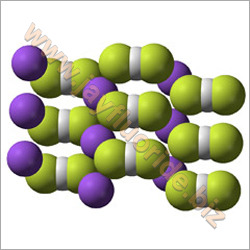Sodium Bifluoride
Product Details:
- Grade Technical Grade
- Melting Point >210C (decomposes)
- Density 2.08 Gram per cubic centimeter(g/cm3)
- Smell Odorless
- Product Type Chemical Compound
- Usage Industrial processing
- Taste Acrid
- Click to View more
Sodium Bifluoride Price And Quantity
- 80.00 - 90.00 INR/Kilograms
- 50 Kilograms
- 80 INR/Kilograms
Sodium Bifluoride Product Specifications
- 2.08 Gram per cubic centimeter(g/cm3)
- >210C (decomposes)
- Technical Grade
- Acrid
- Chemical Compound
- Industrial processing
- Odorless
- 28261990
- 12 months
- Corrosive, releases HF in contact with acids
- Powder
- YES
- 61.99 g/mol
- 98%
- White crystalline powder
- Crystalline
- Glass etching, metal cleaning, wood preservation, laundry sours
- Soluble in water, insoluble in alcohol
Sodium Bifluoride Trade Information
- 100 Kilograms Per Day
- 1 Week
Product Description
Leveraging on our prolific expertise and skills, we are reckoned as a prestigious manufacturer and supplier of Sodium Bifluoride. We use premium quality compounds and latest methodologies for formulating this range of chemical compounds. These chemicals are widely used in electroplating, textile industry, galvanizing baths and laundering. Sodium Bifluoride offered by us is recognized in the market for their properties like impeccable pH value, precise composition and purity. Various compositions are available in our offered range to meet diverse requirements of our various clients.
Bifluoride Uses- As a "sour" in laundering
- In pest control and insect proofing agent for leather
- In textile industry for removal of iron rust
- As a neutralization agent
CAS No. 1333-83-1
HS Code: 2826 19 00
UN No: 2439
Formula: NaHF2
Synonyms: Sodium Di Fluoride
Physical and Chemical Properties
- Mo. Wt: 62.01
- Physical State: White powder
- Specific Gravity: 2.08
Technical Specifications
- Appearance: White powder
- Assay: 98.60% min
- Free SiO2: 0.10% max
- Insolubles: 0.40% max
- Heavy metals: 0.01% max
- Fe: 20ppm max
Packing: 50 kgs HDPE Bags
Product Details:
| CAS NO | 1333-83-1 |
| Insolubles | 0.40 % max |
| Heavy Metals | 0.01 % max |
| Iron | 20 ppm max |
| HS CODE | 2826 19 00 |
| UN NO | 2439 |
| Molecular Formula | NaHF2 |
| Synonym Name | Sodium Di Fluoride |
| Molecular Weight | 62.01 |
| Appearance | White Powder |
| Assay | 98.60 % min |
| Silicon Dioxide | 0.10 % max |
| Physical State | Crystals |
| Usage | Laboratory |
| Packaging Size | 50 Kg |
| Packaging Type | HDPE Bags |
Versatile Industrial Applications
Sodium bifluorides unique chemical properties make it invaluable in a range of industrial processes. It is commonly used for glass etching, metal surface cleaning, wood preservation, and in laundry sours. The compounds effectiveness across such varied applications is due to its ability to react vigorously, particularly with acids, releasing hydrogen fluoridea trait harnessed in several industrial processes.
Safe Handling and Storage
Due to its corrosive and toxic nature, sodium bifluoride must be handled with proper protective equipment. Store it in a cool, dry, and well-ventilated area, away from acids and moisture. The substance is stable under recommended storage conditions but decomposes at high temperatures, releasing hazardous fumes. Adhering to these guidelines ensures both worker safety and product longevity.
Environmental and Health Precautions
Sodium bifluoride poses a hazard to aquatic life and can be harmful if inhaled or in contact with skin. Immediate action is necessary in cases of exposure, including moving affected individuals to fresh air and thoroughly rinsing skin. Waste and unused material should be disposed of in full accordance with local environmental regulations to minimize ecological impact.
FAQs of Sodium Bifluoride:
Q: What are the main industrial uses of sodium bifluoride?
A: Sodium bifluoride is widely utilized in glass etching, metal cleaning, wood preservation, and as a laundry sour. Its reactivity, particularly its ability to release hydrogen fluoride, makes it essential for these industrial processes.Q: How should sodium bifluoride be stored to ensure safety and stability?
A: Sodium bifluoride should be stored in a cool, dry, well-ventilated place, away from acids and moisture. Proper storage helps maintain stability and prevents the release of harmful fumes due to decomposition.Q: When does sodium bifluoride decompose, and what are the resulting hazards?
A: Sodium bifluoride decomposes at temperatures above 210C or upon contact with acids, releasing toxic and corrosive fumes such as hydrogen fluoride (HF). Adequate ventilation and temperature control are crucial during handling.Q: What is the recommended process for disposing of sodium bifluoride waste?
A: All waste containing sodium bifluoride should be disposed of according to local environmental and hazardous waste regulations. It should never be released into the environment due to its harmful effects on aquatic life.Q: How can sodium bifluoride exposure be managed in case of an accident?
A: Inhalation exposure requires moving the individual to fresh air. If the powder contacts skin, wash immediately with copious amounts of water and seek medical attention without delay. Always follow workplace safety protocols.Q: Where does sodium bifluoride offer benefits in industrial processing?
A: Its corrosive and reactive properties allow it to efficiently clean metals, etch glass surfaces for decorative or functional purposes, and preserve wood. These benefits are particularly valued in manufacturing and processing industries.
Price:
- 50
- 100
- 200
- 250
- 500
- 1000+
 |
JAYFLUORIDE PRIVATE LIMITED
All Rights Reserved.(Terms of Use) Developed and Managed by Infocom Network Private Limited. |






